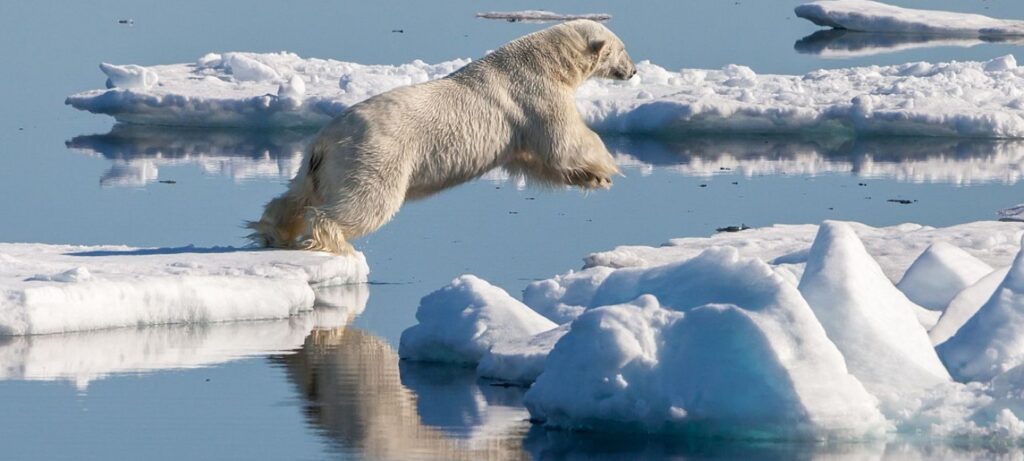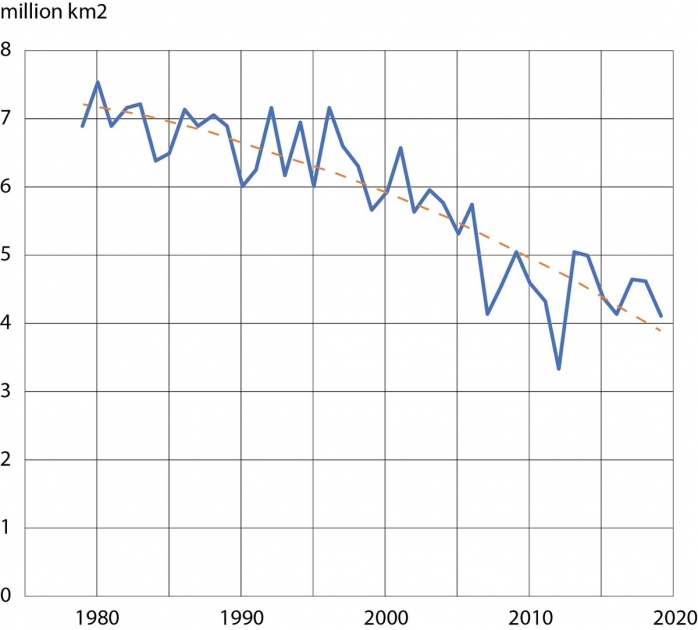Another Wake-Up Call: Sea Ice Loss Is Speeding Up
ENVIRONMENT, 5 Oct 2020
UN Environment Programme - TRANSCEND Media Service
28 Sep 2020 –Unprecedented wildfires, storms and glacier melt are the strongest indications yet of how climate change threatens life on Earth. The world has seen big declines in summer sea ice in the last two decades, with the lowest extent recorded in 2012.
13 September 2020 marked a new, troubling milestone – with Arctic sea ice shrinking to the second-lowest extent ever recorded. We asked United Nations Environment Programme (UNEP) climate change expert Pascal Peduzzi to explain the significance of sea ice loss.
UNEP: What happens to sea ice in the Arctic may seem remote and irrelevant to our daily lives. Why does sea ice loss matter?
Pascal Peduzzi: It matters because the extent of sea ice affects local ecosystems, regional and global weather patterns, and ocean temperatures and circulation. If Arctic sea ice continues to shrink, we may see a summer ice-free Arctic Ocean by the mid-2040s and the disappearance of polar bears and other animals. However, there are also global consequences. Snow and ice help keep the planet cool because they reflect the sun’s rays back into space. Warmer temperatures mean Arctic sea ice is reduced, ocean temperatures rise, and the warmer water (with a bigger volume) contributes to sea-level rise.
The lowest extent of sea ice on record was in 2012. Last year’s extent was almost as small, and now this year, on 13 September, we saw the second-lowest ever recorded Arctic sea ice minimum (3.709 million square kilometres). In addition, in 2020, the area of Arctic Sea Ice was the lowest on record for the month of July.

Graph showing the Arctic sea ice extent. Graph by UNEP
UNEP: Why is this happening? What is causing the loss of sea ice?
PP: Increasing emissions of greenhouse gases, principally carbon dioxide (CO2), are to blame. The global trend in the increase in CO2 concentration is not only rising but accelerating. In 1960 it was +0.9 parts per million (ppm) per year, in 1980 +1.21 ppm; in 2000 +1.83 ppm and in 2020 it is +2.51 ppm/year. Global heating is real. There is a strong correlation in the long-term trends between CO2 emissions and atmospheric CO2 levels and we’re in danger of missing key Paris Climate Agreement goals as the emissions gap widens.
UNEP: What is UNEP doing to highlight the dangers?
PP: UNEP’s annual Emissions Gap Report along with the World Environment Situation Room are painting a worrying picture. Monthly global temperatures for January, February, March and July 2020, were the second warmest since records began in 1880, while in April, May and June 2020 they were the warmest ever on record since 1880.
UNEP: What are the implications?
PP: Reduced Arctic sea ice means increased ocean temperatures. Combined with melting glaciers on land, this contributes to sea-level rise, which is accelerating. Between 1994 and 2010 sea-level rise averaged 3.3 mm per year, but since 2010 it has been rising at an average of 5.7 mm per year.
A warming world threatens the planet’s library of life, including our own existence. We need to change the way we do agriculture, our industry, the way we travel, and how we heat and cool our homes. We need to ramp up renewable energy and rapidly phase out fossil fuels. We need to implement nature-based solutions and introduce a circular economy. Solutions exist, but their implementation is too slow. We also need more data and science. Governments need to get serious about climate action.
The United Nations Decade of Ocean Science for Sustainable Development (2021 – 2030) proclaimed in December 2017, will provide a common framework to ensure that ocean science can fully support countries’ actions to sustainably manage the oceans and more particularly to achieve the 2030 Agenda for Sustainable Development.
For more information, please contact Pascal Peduzzi: Pascal.Peduzzi@un.org
Tags: Arctic, Climate Change, Earth, Environment, Global warming
DISCLAIMER: The statements, views and opinions expressed in pieces republished here are solely those of the authors and do not necessarily represent those of TMS. In accordance with title 17 U.S.C. section 107, this material is distributed without profit to those who have expressed a prior interest in receiving the included information for research and educational purposes. TMS has no affiliation whatsoever with the originator of this article nor is TMS endorsed or sponsored by the originator. “GO TO ORIGINAL” links are provided as a convenience to our readers and allow for verification of authenticity. However, as originating pages are often updated by their originating host sites, the versions posted may not match the versions our readers view when clicking the “GO TO ORIGINAL” links. This site contains copyrighted material the use of which has not always been specifically authorized by the copyright owner. We are making such material available in our efforts to advance understanding of environmental, political, human rights, economic, democracy, scientific, and social justice issues, etc. We believe this constitutes a ‘fair use’ of any such copyrighted material as provided for in section 107 of the US Copyright Law. In accordance with Title 17 U.S.C. Section 107, the material on this site is distributed without profit to those who have expressed a prior interest in receiving the included information for research and educational purposes. For more information go to: http://www.law.cornell.edu/uscode/17/107.shtml. If you wish to use copyrighted material from this site for purposes of your own that go beyond ‘fair use’, you must obtain permission from the copyright owner.

